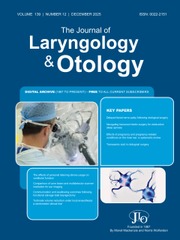Article contents
Simultaneous, laser-sintered, three-dimensional modelling of bony structures and soft tissue for surgical navigation of extended cholesteatoma
Published online by Cambridge University Press: 19 November 2009
Abstract
To examine the usefulness of a three-dimensional model for surgical navigation of cholesteatoma.
A three-dimensional model was prototyped using selective laser sintering. Based on detailed computed tomography data, powder layers were laser-fused and accumulated to create a three-dimensional structure. The computed tomography threshold was adjusted to simultaneously replicate bony structures and soft tissues.
The cholesteatoma, major vessels and bony structures were well replicated. This laser-sintered model was used to aid surgery for recurrent cholesteatoma. The cholesteatoma, which extended from the hypotympanum through the styloid process sheath and the internal carotid artery sheath, was removed safely via a minimal skin incision.
The laser-sintered model was useful for surgical planning and navigation in a cholesteatoma case involving complex bony structures and soft tissue.
Information
- Type
- Clinical Records
- Information
- Copyright
- Copyright © JLO (1984) Limited 2009
References
- 4
- Cited by

